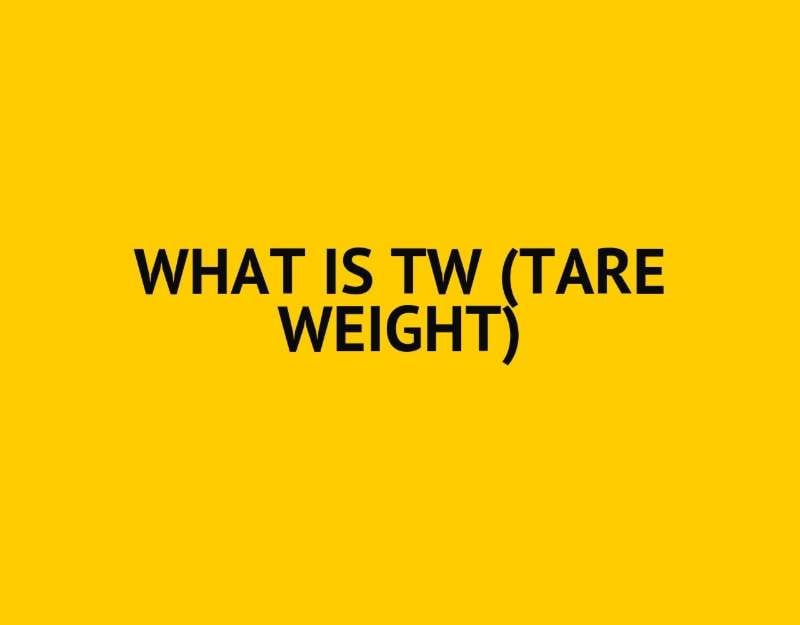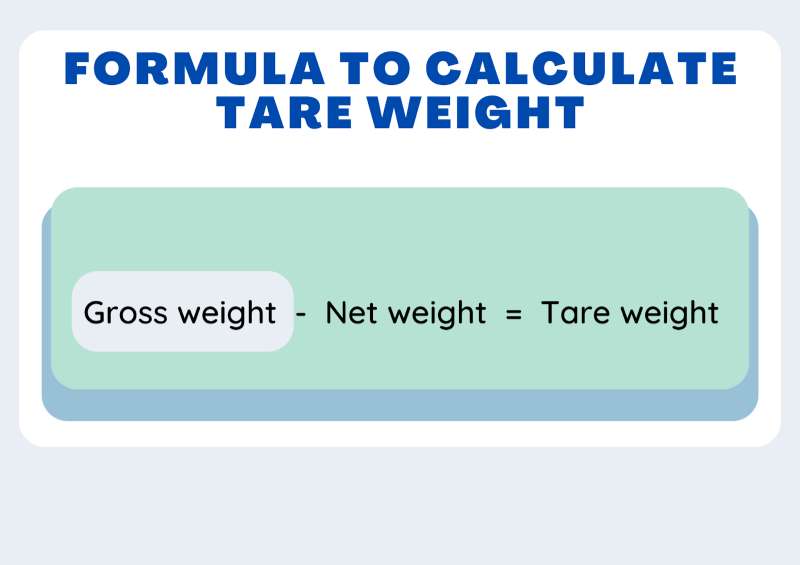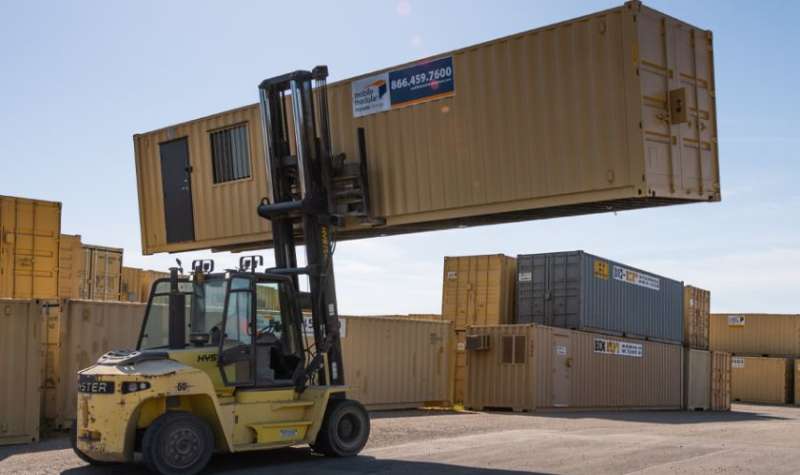Tare weight is a critical factor affecting shipping costs and toll charges on roads and railways. It gives insight into whether the intermodal shipment is legal. Freight and Logistics companies should understand various tare weight requirements in different regions to avoid legal charges.
As a trusted sourcing company, we have a decade of industry experience and compiled a detailed guide covering all the fundamental principles of tare weight.
This article explains all you need to know about tare weight and how to measure it. In the end, you’ll be able to differentiate tare weights from different weights, such as gross weight.
Let’s dive in!

What does tare weight mean?
Tare weight, also known as unladen weight, refers to the weight of an empty container, car, or vehicle. Subtracting the tare weight from the gross weight gives the net weight of the cargo or shipment.
In simple terms, tare weight is the weight of a vehicle when it’s not carrying any goods or passengers. In reference to a vehicle, tare weight encompasses all body parts of the car when being driven on the road. Yet, tare weight does not include batteries in an electric vehicle.
We can categorize tare weights into two parts. First is the actual tare weight. It’s the net weight of the container, excluding the weights of pallets and other packaging materials. Second is the average tare weight. This is the sum of all tare weights of different containers divided by the number of containers.
Tare weight gives the shipping company and recipient an estimate of the customs taxes and shipping expense – of the correct cargo weight. Excluding the container’s gross weight.
Suggested reading: Shipping Guide: Difference Between Net Weight vs Gross Weight
A Fast , Easy and Cheap Way to Ship from China
Do not hesitate to contact Leeline Sourcing at any time regarding your shipments from China.
How do you calculate tare weight for shipping?

You calculate tare weight by subtracting the net weight from the total gross weight. The difference is the actual weight of the shipping container.
The net weight is a word used to refer to the weight of cargo carried in the shipping container. In contrast, gross weight is the total weight, including goods, packaging, wrapping materials, and shipping container.
Do you know how to calculate? I have added an EXAMPLE to get the price.
A freight company intends to ship vehicles from China to the United States. Each vehicle weighs 2690 Kilograms. They then place the two cars in a single container bringing the total weight to 9,160 Kilograms. They subtract the net weight from the gross weight to get the tare weight. Afterward, they publish the tare weight on the doors of the container.

“Here’s a container showing the maximum gross weight, tare, and net weight.”
We can use it to compute toll charges and taxes levied on shipment containers.
What is the meaning of to Tare a Balance?
Taring a balance involves setting the digital display to read zero. Most digital balances have the tare feature, which aids in taring the balance. You only have to switch on the balance before pressing the tare button. As a result, the mass of any item is determined automatically without calculation.
But why is taring a balance important?
For instance, if you place an item weighing 50 kilograms on the tared balance, the digital display only shows 50 kilograms. However, you’ll get an incorrect reading if you don’t tare the balance. Maybe you had measured a package that weighed 24 Kilograms, then immediately placed the last item. You’ll notice a reading of 74 Kilograms which is inaccurate.
When taring a balance, always be careful not to overload the balance. For example, imagine that the largest capacity of your balance is 10,000 kilograms. You then tare two pallets weighing 1000 kilograms. This way, you’re left with a weighing range of 9,000 kilograms. The scale will be overloaded if you place luggage with weight beyond the remaining scope.
Is tare the same as zero?
Both tare and zero have similar functions on a scale but are not the same. Several factors tend to set them apart. For instance, tare functions are useful while determining the individual weight of items on a scale. For example, let’s say you are weighing coffee seeds and want to remove the weight of the packing material, then use the tare function.
The zero function becomes applicable only when the scale doesn’t read zero, yet it’s empty. The zero function aids in the removal of the unwanted weight of buildup, including dust or rust. In short, tare removes the unwanted weight on the scale (e.g., the weight of a container), while zero reinstates the scale to zero when the pan is empty.
How to Tare a Scale?

Taring a scale is relatively easy, as many digital scales feature a tare button that allows you to zero the weight of the container before placing items in it. This will give you the net weight of the items in the container.
This is how you tare your scale in two easy steps;
Step 1: Hit the power button to turn on the digital scale.
Step 2: Allow the display some time before pressing the tare function. This will automatically zero the scale.
Step 3: Place the container on the scale.
Now that you know how to tare your scale, here’s how to use it to determine the correct net weight of products in a container;
- I turn on your digital scale and place an empty container. Then I press the tare function to zero the scale and get a zero value.
- Set up the container on the scale and put the products into the container. The digital stabilizer automatically determines the net weight of the product.
Note: Once you remove the container from the tared scale, the digital scale gives a negative reading. The negative value represents the tare weight of the container. To return the scale to zero, remove all items from the scale, then press the tare button.
FAQs about Tare Weight
1. What is tare weight vs. net weight?
Tare weight, also called unladen weight, is the intermodal container weight and packaging upon which an item is shipped. Net weight is the weight of the raw product being transported. In addition, tare weight includes the weight of packing while net weight doesn’t include the same.
2. Will fuel be included in tare weight?
Yes. Tare weight is the measured weight of an empty vehicle ready to be driven. The unladen weight doesn’t include luggage, passengers, or other items. But, only ten liters of fuel should be in the tank.
3. What are the Weights Shown on a Bill of Lading?
A bill of lading usually has two figures on it. That is the correct tare weight of the shipping container, and the gross weight of the load carried. All measured weights must be accurate. Helps to avoid equipment malfunction or collapse of containers during shipment.
What’s Next
Tare weight is the weight on an empty vehicle or empty container. Thus, it is crucial to determine the shipping cost for goods to avoid extra shipping costs. Or, it can be helpful in body composition assessment, especially during underwater weighing. For example, freight companies often publish tare weight on the sides or door of the container. Consequently, this allows a more straightforward computation of cargo weight.
Do you want to ensure that all your shipments meet the weight requirements? Worry not. We at Leeline Sourcing will ensure that all your cargo meets your quality control needs. Reach us out on our service pages to get a quote.








